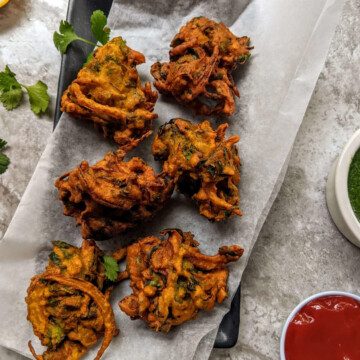
Palak Pakoda Recipe
Palak Pakoda is a crispy Indian snack made from fresh spinach leaves coated in spiced gram flour batter and deep-fried until golden brown. It's a delicious and crunchy treat, often served as an appetizer or tea-time snack, typically enjoyed with chutney or sauce. Packed with the goodness of spinach, it's both flavorful and nutritious!
Ingredients
Ingredients:
- 2 Cup Fresh spinach leaves, washed and finely chopped
- 1 Cup Gram flour (besan)
- 1 Small onion, finely chopped (optional)
- 1 teaspoon Cumin seeds
- 1 teaspoon Carom seeds (ajwain)
- 1 teaspoon Red chili powder
- ½ teaspoon Turmeric powder
- ½ teaspoon Garam masala (optional)
- ½ teaspoon Chaat masala (for extra flavor)
- Salt to taste
- ½ teaspoon Baking soda (optional for extra crispiness)
- ¼ Cup Water as needed (approx.)
- Oil for deep frying
Instructions
Simple Preparation
Wash & Dry the Spinach:
- First, wash the fresh spinach leaves thoroughly to remove any dirt. Then, dry them well with a kitchen towel or let them air dry. This step is important because it prevents excess moisture from making the batter soggy, ensuring your pakodas stay crispy!
Chop the Spinach:
- Once dry, chop the spinach into small, bite-sized pieces. You can keep them a little coarse or finely chop, depending on your preference. I personally love keeping the pieces a bit chunky for a nice bite!
Mix the Batter:
- In a mixing bowl, combine gram flour (besan), rice flour (for extra crispiness), and your spices (turmeric, cumin powder, chili powder, and salt).
- Stir it all together. Gradually add water—just enough to make the batter thick, but not runny. The consistency should be like pancake batter: thick enough to coat the spinach but not so thick that it doesn't stick.
Detailed Method
- Achieving the Right Consistency:
- The key to perfect pakodas is getting the batter just right. If it's too thick, the pakodas will be dry; if it's too runny, they won't crisp up properly. I’ve learned this the hard way—one time, I made the batter too watery, and the pakodas just fell apart! So, aim for a smooth, thick batter that sticks to the spinach leaves.
Frying the Pakodas:
- Heat enough oil in a pan or deep fryer for the pakodas to float while frying. The oil should be hot enough that the pakodas sizzle when dropped in but not too hot that they burn. Use a spoon to carefully drop spoonfuls of the batter into the oil.
- Fry until golden brown and crispy, turning them halfway through. This usually takes around 4-5 minutes. You’ll know they’re done when they’re crispy, not greasy. Once done, place them on a paper towel to remove excess oil. 🧻
Quick and Easy Option
Faster Version:
- If you’re in a rush, you can simplify the recipe by using fewer spices. Just mix spinach, gram flour, salt, and a pinch of chili powder or cumin powder. No need to measure out many spices, and this still gives you a tasty snack!
Healthier Baked Version:
- For a healthier option, skip the deep frying. Preheat your oven to 180°C (350°F), then arrange spoonfuls of the pakoda batter on a baking sheet lined with parchment paper. Bake for about 15-20 minutes, flipping halfway, until crispy and golden. This method cuts down on the oil but still gives you a crunchy treat!
Notes
Palak Pakoda Variations
1. Stuffed Palak Pakoda: For a fun twist, stuff spinach leaves with a spiced potato or paneer mixture before dipping in batter and frying. It’s like a surprise inside every bite! 2. Vegetable Pakoda: Next, add onions, carrots, or corn to the batter for a burst of flavor. This is a fun and easy way to sneak in extra veggies while making the pakodas even tastier! 3. Moong Dal Pakoda with Spinach: Add moong dal (yellow lentils) to the spinach batter for extra protein and a different texture. It’s both healthy and delicious! 4. Baked Palak Pakoda: For a healthier option, bake the pakodas in the oven instead of frying. This gives you the same crispy texture with less oil!Nutrition
Nutrition Facts
Palak Pakoda Recipe
Amount per Serving
Calories
220
% Daily Value*
Fat
11
g
17
%
Saturated Fat
1.8
g
11
%
Polyunsaturated Fat
2
g
Monounsaturated Fat
6.3
g
Sodium
150
mg
7
%
Potassium
200
mg
6
%
Carbohydrates
24
g
8
%
Fiber
4
g
17
%
Sugar
1.3
g
1
%
Protein
9
g
18
%
Vitamin A
1000
IU
20
%
Vitamin B1
0.12
mg
8
%
Vitamin B2
0.1
mg
6
%
Vitamin B3
0.5
mg
3
%
Vitamin B5
0.12
mg
1
%
Vitamin B6
0.1
mg
5
%
Vitamin C
7.5
mg
9
%
Vitamin E
0.25
mg
2
%
Vitamin K
75
µg
71
%
Calcium
38
mg
4
%
Iron
1.5
mg
8
%
* Percent Daily Values are based on a 2000 calorie diet.
Tried this recipe?Let us know how it was!